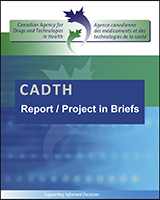Except where otherwise noted, this work is distributed under the terms of a Creative Commons Attribution-NonCommercial- NoDerivatives 4.0 International licence (CC BY-NC-ND), a copy of which is available at http://creativecommons.org/licenses/by-nc-nd/4.0/
NCBI Bookshelf. A service of the National Library of Medicine, National Institutes of Health.
CADTH Report / Project in Briefs [Internet]. Ottawa (ON): Canadian Agency for Drugs and Technologies in Health; 2011-2021.
Key Messages
- For people with Functional Class (FC) II or III pulmonary arterial hypertension (PAH), all single-drug therapies appear similarly effective at preventing the disease from worsening. Sildenafil or tadalafil generally provide the best value, so these are preferred first-line treatments for most patients. For people with FC I or IV PAH, there is not enough evidence to make a recommendation.
- Add-on therapy should be offered to patients whose PAH is not controlled with single-drug therapy. Consider the balance of potential benefits versus potential increases in adverse events.
- The decision to change or add therapies should be based on patient-specific factors and response, and should be made by a PAH specialist working in one of Canada’s designated pulmonary hypertension centres.
Condition
Pulmonary arterial hypertension (PAH) is a complex and progressive disease characterized by increased pressure in the pulmonary artery (the blood vessel that carries blood from the heart to the lungs). Patients commonly experience shortness of breath, swelling of ankles and legs, dizziness, or fainting. On average, patients live about five to seven years after diagnosis.
The disease most commonly affects people between 20 and 40 years of age, and is more common in women than men. There are estimated to be between 313 and 767 Canadian adults with PAH.
The World Health Organization has developed a classification system for PAH based on level of function and symptoms. Patients may have Functional Class (FC) I through IV, with increasing numbers reflecting increased severity.
Drugs
Supportive therapy includes oxygen, diuretics to reduce fluid accumulation, anticoagulants to prevent blood clots, and other measures aimed at treating symptoms. Most patients will require advanced therapy —drugs that aim to treat the disease itself. Eight such drugs are approved in Canada. They belong to four classes:
- prostanoids (injectables: epoprostenol, treprostinil)
- endothelin receptor antagonists (oral: bosentan, ambrisentan, macitentan)
- phosphodiesterase type-5 (PDE-5) inhibitors (oral: sildenafil [both oral and injectable], tadalafil)
- soluble guanylate cyclase (sGC) stimulator (oral: riociguat)
Patients whose disease is not well controlled with a single drug (monotherapy) are usually offered combination therapy with a second drug.
Issue
PAH is treated in specialized clinics by experts who often need to intervene aggressively against a severe and fatal disease. However, with large variations in practice, and new treatments available, a review of clinical effectiveness, safety, and cost-effectiveness will help to inform decisions about PAH therapy.
Methods
An expert committee made recommendations based on a systematic review of the scientific evidence for these drugs and an economic analysis.
Results
The systematic review included 20 unique studies. None of the studies provided direct (“head-to-head”) comparisons of advanced therapies, so a network meta-analysis was conducted to allow indirect comparisons. Most studies measured changes in six-minute walk distance, a measure that does not reliably reflect more important outcomes such as hospitalization or death.
- DISCLAIMER: The information in this document is intended to help health care decision-makers, patients, health care professionals, health systems leaders, and policy-makers make well-informed decisions and thereby improve the quality of health care services. This information should not be used as a substitute for the application of clinical judgment in respect of the care of a particular patient or other professional judgment in any decision-making process nor is it intended to replace professional medical advice. While CADTH has taken care in the preparation of this document to ensure that its contents are accurate, complete, and up-to-date, CADTH does not make any guarantee to that effect. CADTH is not responsible for any errors or omissions or injury, loss, or damage arising from or as a result of the use (or misuse) of any information contained in or implied by the information in this document.CADTH takes sole responsibility for the final form and content of this document. The views expressed herein are those of CADTH and do not necessarily reflect the views of our funders.
- Review Identifying Patients with Pulmonary Arterial Hypertension Using Administrative Claims Algorithms.[Ann Am Thorac Soc. 2019]Review Identifying Patients with Pulmonary Arterial Hypertension Using Administrative Claims Algorithms.Mathai SC, Hemnes AR, Manaker S, Anguiano RH, Dean BB, Saundankar V, Classi P, Nelsen AC, Gordon K, Ventetuolo CE. Ann Am Thorac Soc. 2019 Jul; 16(7):797-806.
- Review Advances in targeted therapy for pulmonary arterial hypertension in children.[Eur J Pediatr. 2023]Review Advances in targeted therapy for pulmonary arterial hypertension in children.Li L, Zhu X, Chen X, Gao J, Ding C, Zhang M, Ma S. Eur J Pediatr. 2023 May; 182(5):2067-2076. Epub 2022 Dec 17.
- Clinical trial designs in PAH: shifting from functional measurements to long-term clinical outcomes.[Am J Manag Care. 2014]Clinical trial designs in PAH: shifting from functional measurements to long-term clinical outcomes.Studer SM, Gilkin RJ Jr. Am J Manag Care. 2014 Mar; 20(6 Suppl):S115-22.
- Review New Drugs and Therapies in Pulmonary Arterial Hypertension.[Int J Mol Sci. 2023]Review New Drugs and Therapies in Pulmonary Arterial Hypertension.Shah AJ, Beckmann T, Vorla M, Kalra DK. Int J Mol Sci. 2023 Mar 19; 24(6). Epub 2023 Mar 19.
- Saudi Guidelines on the Diagnosis and Treatment of Pulmonary Hypertension: Medical and surgical management for pulmonary arterial hypertension.[Ann Thorac Med. 2014]Saudi Guidelines on the Diagnosis and Treatment of Pulmonary Hypertension: Medical and surgical management for pulmonary arterial hypertension.Idrees MM, Swiston J, Nizami I, Al Dalaan A, Levy RD. Ann Thorac Med. 2014 Jul; 9(Suppl 1):S79-91.
- Drugs for Pulmonary Arterial Hypertension - CADTH Report / Project in BriefsDrugs for Pulmonary Arterial Hypertension - CADTH Report / Project in Briefs
Your browsing activity is empty.
Activity recording is turned off.
See more...
